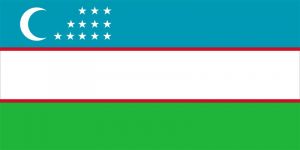Language/Southern-uzbek/Vocabulary/Colors
Hi Southern Uzbek learners! 😊
In this lesson, we will learn about colors in Southern Uzbek. Colors are essential vocabulary words that we use daily in our communication.
Colors around us brighten up our lives and express a variety of emotions, symbolize different cultures, customs and nationalities. We will also learn interesting facts related to the colors that will show us how colors vary from culture to culture. Let's begin our journey into the wonderful world of colors.
Take a moment to explore these relevant pages as you conclude this lesson: Clothes, Education, How to say Good Bye & Health.
Basic Colors[edit | edit source]
We'll start with the basics. Below are some of the most common colors you'll encounter in your day to day life:
| Southern Uzbek | Transcription | English |
|---|---|---|
| Qora | [qoɾɑ] | Black |
| Oq | [oq] | White |
| Piyo | [pijo] | Yellow |
| Kichkina alo | [kɪʧ.kɪ.nɑ ɑ.lo] | Small red |
| Jigarrang | [d͡ʒɪ.gɑr.rɑŋ] | Deep Red |
| Ko'k | [koʔk] | Blue |
| Yashil | [jæʃɪl] | Green |
| To'q sariq | [toʔq særɪq] | Dark yellow |
| Sariq | [særɪq] | Light yellow |
| Go'zal | [gozæl] | Beautiful |
Shades of Colors[edit | edit source]
In Southern Uzbek, you can express different shades of colors by adding adjectives after the color
| Southern Uzbek | Transcription | English |
|---|---|---|
| Oq-sha | [oq.ʃæ] | Bright white |
| Jigarrangli | [d͡ʒɪ.gɑr.rɑŋ.li] | More muted red |
| Yashil-yor | [jæʃɪl.joɾ] | Dark green |
Talking about Colors in Culture[edit | edit source]
Colors play an important role in culture and traditions. In Southern Uzbek, some colors have significant meanings when it comes to cultural symbols and practices. For example, white and black colors have different meanings in different cultures. In Uzbekistan, white is a color of purity, innocence, and represents peace, while black represents sadness, grief and mourning.
In some parts of the country, red, green and white are the most important and symbolic colors for the people of Uzbekistan. These colors represent stability, peace, and independence. We can see many Uzbek national costumes and cultural festivals reflect this symbolism.
Interesting Facts About Colors[edit | edit source]
Here are a few interesting facts you may not know about some of the colors mentioned in our lesson:
- The color blue is one of the most popular and most versatile colors in the world. It symbolizes trust, loyalty, wisdom, confidence, and intelligence.
- The color green is the color of nature, wealth, and prosperity. It symbolizes growth, harmony, freshness, and stability.
- The color red is the most emotionally charged of all the colors. It symbolizes passion, love, energy, and excitement.
Dialogue[edit | edit source]
To better understand how we can use colors in our daily life, here's a conversation:
- Person 1: Jigarrang paxta kelgusi (Deep red shirt)
- Person 2: Yaxon, unda siz kishi ko'rinadi. (Nice, you'll stand out in that.)
- Person 1: Yashil maxsulotlarni sotish uchun bozorqa boraman (I'm going to the market to sell green products)
- Person 2: O'ylashingizdan ko'ra yoshi kichkina yoki katta? (Is it small or large based on what you are thinking?)
- Person 1: Katta. (Large.)
Conclusion[edit | edit source]
Colors are essential vocabulary words used in our everyday life, and by knowing them, we can better express ourselves and understand others. Be sure to practice and use the new vocabulary words you learned in real life scenarios. To improve your [ [Language/Southern-uzbek|Southern Uzbek]] vocabulary, you can also use the Polyglot Club website. Find native speakers and ask them any questions!
➡ If you have any questions, please ask them in the comments section below.
➡ Feel free to edit this wiki page if you think it can be improved. 😎
Excellent job on conquering this lesson! Consider delving into these related pages: Food, Say Hello and Greetings in Southern Uzbek, Fruits & Count to 10.

